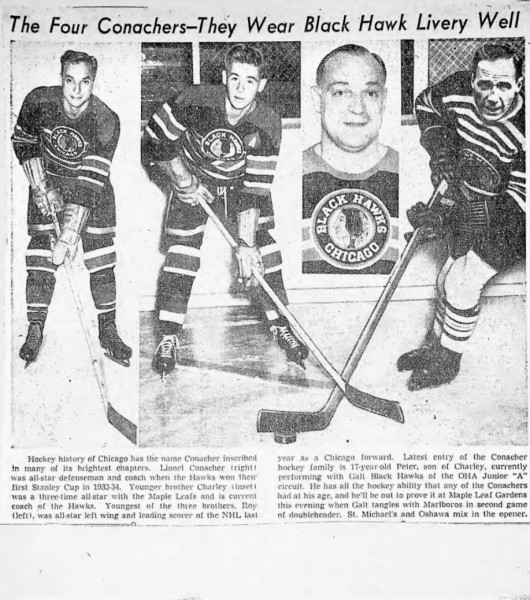
From the Archives: The Four Conachers Wear Black Hawk Livery Well
Regarded as the Royal Family of Canadian sport, the Toronto-born quartet was a force you didn't want to mess with in the early days of the NHL. Stan Fischler looks back at one of hockey's most famous families.

During the late 1940's and 1950's -- with the exception of the 1953-54 Black Hawks -- there was nothing special about the Windy City sextet. Over and Over again, Chicago missed the playoffs until late in the decade when Bobby Hull, Stan Mikita and Glenn Hall sparked the franchise's renaissance.
So, if you can imagine yourself as Toronto Globe and Mail sports editor Jim Vipond in 1950, you'd be challenged to craft a positive story about Chicago's hockey team. But Gentleman Jim did just that one day by taking capsule biographies of four members of the Conacher clan and then weaving them into one photo montage.
The Globe and Mail pix were topped with a headline: THE FOUR CONACHERS -- THEY WEAR BLACK HAWK LIVERY WELL.
Regarded as the Royal Family of Canadian sport, the Toronto-born quartet included its senior member, Lionel (far right in the photo) alias "The Big Train." So adept had Lionel been at so many sports, that when the photo appeared in 1950, he had been voted "Canada's Athlete Of The Half-Century." Lionel won his HOCKEY epaulets at Chicago Stadium helping the Hawks to their first Stanley Cup in the 1933-34 season. Lionel was both an all-Star defenseman and coach in The Windy City.
The clan's kid brother, Roy Conacher, (far left) starred for Chicago and in 1948-49 he led the NHL in scoring. Like his brothers, Roy was an all-star and Hockey Hall of Famer. Older brother, Charlie, (inset, second from right) was calling the shots behind the Black Hawks bench when this photo appeared. A former right wing star with the Maple Leafs Kid Line -- Conacher, Joe Primeau, Busher Jackson -- Charlie had been a three time right wing All-Star in Toronto. During the early 1930's it was said that Charlie owned the NHL's hardest shot, especially in 1931-32 when the Leafs won their first Stanley Cup.
Off-ice, Charlie had little coaching success with Chicago but achieved notoriety after a heated Black Hawks-Red Wings game. During a post-match media scrum, Conacher took exception to a question tossed by Detroit Times writer Lew Walter and punched the journalist, knocking him for a loop. Charlie later modestly was fined by president Clarence Campbell for his KO blow.
Meanwhile, Charlie's son, Peter (second from left) had become a Junior ace with the OHA Junior A Galt Black Hawks. "Pete had all the hockey ability that any of the Conachers had at his age," wrote Vipond. But when it came to pro hockey, Peter was less than a first-liner.
After a rather mediocre Black Hawks career, Pete was traded to the New York Rangers on (American) Thanksgiving Eve, 1954, along with defenseman Bill Gadsby. It was considered a huge deal at the time and in exchange the Hawks obtained defenseman Allan Stanley and forward Nick Mickoski.
"When I made the trade," said Rangers manager Frank Boucher, "I'd hoped that Pete would continue to mature from his starry days with the Galt Juniors. Unfortunately, he never got past the most modest NHL point."
I happened to be the Rangers assistant publicist during the 1954-55 season and recall intently waiting for Pete Conacher to blossom the way his dad had done in Toronto. Alas, I waited in vain. Eventually Pete moved on to the Maple Leafs and concluded his inauspicious NHL career with a long career in the minors.
In the end only Roy and Lionel achieved meaningful success with Chicago. Charlie was a disappointment behind the bench. By contrast, former Red Wings ace Sid Abel became player-coach of the Illinois skaters during the 1953-54 season and paced them to the playoffs. Perhaps Pete might have succeeded had Chi management allowed him to hone his game to sharpness in the minors. But he was rushed to The Show too soon by a desperate, losing ownership and exited as the Conacher clan's lone hockey-playing failure in the NHL.
(P.S. One result of the much-ballyhooed Gadsby-Stanley exchange was each player eventually made it to the Hall of Fame.)